Truck Reconciliation
This feature is used to compare assets which were loaded on the truck and unloaded from the truck against assets which were delivered and returned during the truck's run.
NOTE
Take note of the difference between a “Load Truck” and a “Truck Load”. These can be confusing if not used correctly.
-
Load Truck is an action which was done on a handheld.
-
Truck Load is a set of Load Truck actions, Delivery actions, and Unload Truck actions which are grouped together to represent the entire run which was made with the truck. A Truck Load is generally a run completed in one day, although it is possible for a Truck Load to span multiple days.
Preparing for the Reconciliation
Before beginning the reconciliation Process
-
Make sure all driver devices are synced and records are saved
-
All collisions associated with that truck MUST be resolved prior to reconciling a truck, or you won’t be able to create the load.
Creating the Truck Load
Go to Truck Load/Unload > Create Truck Load.
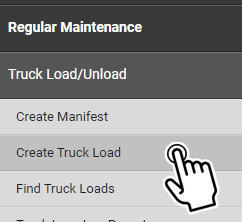
Click Search to list trucks with unresolved loads at the selected location (Branch) within the selected number of days (Limit to Last).
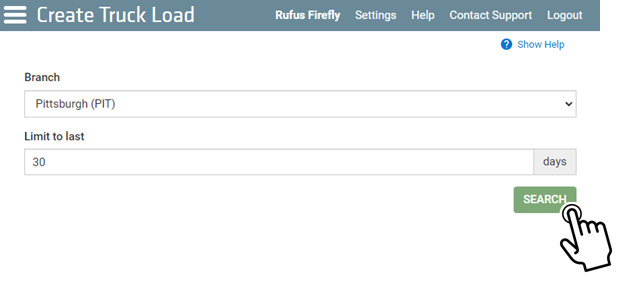
Select a truck by clicking it.

For each Load Truck Action there should be an Unload Truck Action.
SELECT the Unload Truck Action that pairs with the Load Truck Action you selected. This is typically the Unload Truck action that occurred on the same delivery period as the Load Truck action.
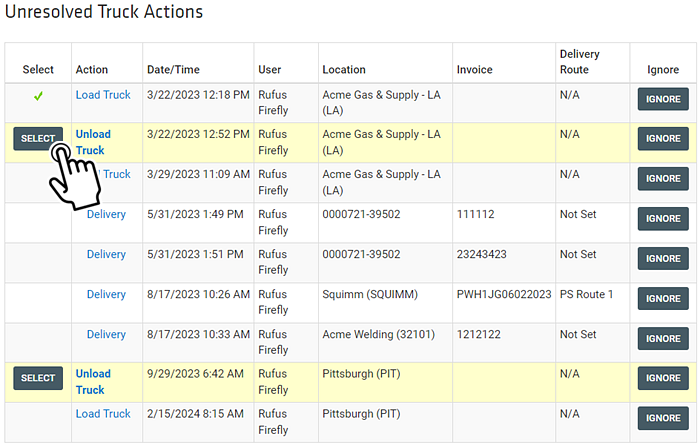
This reconciles the truck load by automatically selecting all Load/Unload Truck actions and all Deliver/Return actions between the Load Truck action you selected and the Unload Truck action you selected. All of these actions are then grouped together to form the truck's run (the Truck Load). If the automatic selection is correct, click CONTINUE.
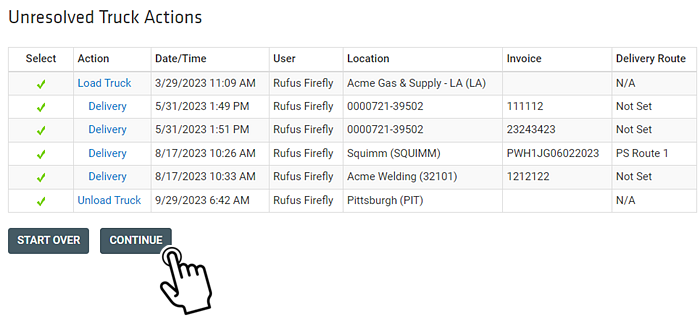
Review the Truck Load
Next, TrackAbout displays the Truck Reconciliation page. Here users can review assets with problems, such as assets which were loaded onto the truck, but neither delivered nor unloaded.
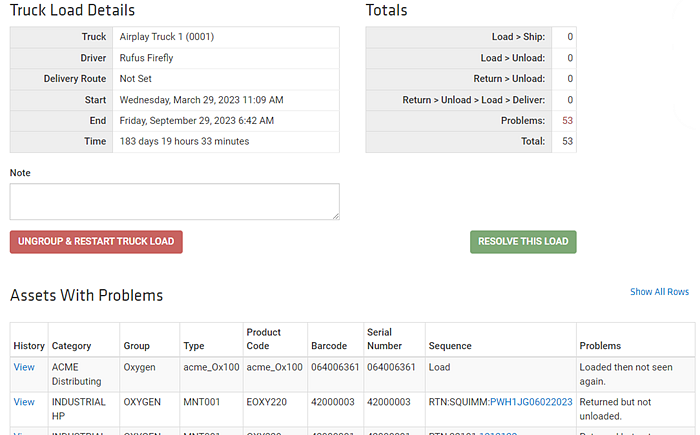
Reconciling the Truck Load
The Truck Load may then be resolved as is, or corrections may be made prior to resolving.
Once the Truck Load has been resolved, the user will see a final page from which they have three options:
-
Unresolve This Load — This will take you back into the Truck Load if you need to review again any problems with the Load.
-
Ungroup & Restart Truck Load — This will undo the reconciliation and take you back to the beginning to create a new Truck Load.
-
Remove Asset from Truck — This allows you to remove any remaining assets from the Truck Inventory.
Troubleshooting Load Issues
TrackAbout will identify for you discrepancies we find in your Truck Load. Here are some common messages you may see and some notes about what has caused the issue:
| ScenarioType | Message | Behavior the invokes the message | Troubleshooting Tips |
|---|---|---|---|
| Normal | LoadedAndDelivered | One or two Loads followed by a Deliver | None Needed |
| Normal | ReturnedAndUnloaded | A Return followed by one or two Unloads | None Needed |
| Normal | LoadedAndUnloaded | One or two Loads followed by one or two Unloads | None Needed |
| Normal | ReturnedRefilledLoadedAndDelivered | A Return, one or two Unloads, one or two Loads, and a Deliver | None Needed |
| Normal | LoadedAndDelivered | A Load/Unload sequence, followed by Load and Deliver. | None Needed |
| Normal | LoadedAndUnloaded | Loaded and unloaded twice. | None Needed |
| Exception | DeliveredNotLoaded | A single Deliver | Look to be sure all appropriate Load Truck records were synced and included in the Load Grouping. |
| Exception | ReturnedNotUnloaded | A single Return | Look to be sure all appropriate Unload Truck records were synced and included in the Load Grouping. |
| Exception | LoadedThenNotSeen | One or more Loads | Make sure all deliveries were synced and associated with the correct Truck. |
| Exception | UnloadedNotLoadedOrReturned | One or more Unloads | Make sure all Load Truck and deliveries were synced and associated with the correct Truck. |
| Exception | LoadedThenReturned | One or two Loads then a Return | Make sure all deliveries were synced and associated with the correct Truck. |
| Exception | DeliveredThenUnloaded | Delivered then one or two Unloads | Could be that driver did not leave the asset with the customer. |
| Exception | LoadedDeliveredUnloaded | One or two Loads, a Deliver, and one or two Unloads | Could be that driver did not leave the asset with the customer. |
| Exception | LoadedReturnedUnloaded | One or two Loads, a Return, then one or two Unloads | Asset was not properly captured as a delivery and left with the customer. |
| Exception | LoadedThenDeliveredTwice | One or two Loads, followed by exactly two Delivers | Captured on a delivery but not left with the customer. Then scanned again on a different transaction. |
| Exception | ReturnedTwiceThenUnloaded | Returned exactly twice, then one or two Unloads | (Would not happen with Delivery with Integrated Order Sync) |
| Exception | EmptyCylinderDelivered | Returned then Delivered | Shouldn't happen for customers using Delivery with Integrated Order Sync and Use State Validation. User should see an alert on the device to indicate the asset is empty |
Loads with Branch Transfers
The behavior of the page for Branch Transfer records depends on the route that was selected while creating the Truck Load grouping. For assets in a Branch Transfer records, we use the route to determine if the asset should be treated as a Delivery or a Return.
If the location of the route matches the location of the destination location of the assets, we treat the asset as a return. Otherwise we treat the asset as a delivery.
Reconciling with Delivery with Integrated Order Sync
If you are using the Delivery with Integrated Order Sync module, your screens during the reconciliation process will look different:
-
On the Truck Reconciliation page, you will see orders and deliveries related to the truck load so you can verify them as part of your Truck Load Reconciliation process
-
After selecting the last Unload Truck record, you will be able to choose a Delivery Route
-
Choosing a Delivery Route will show all the orders associated with the route, whether or not they were delivered in the verification portion of the Truck Load Reconciliation page
-
Not choosing a Delivery Route will only show the deliveries actually made from that truck in the verification portion of the Truck Load Reconciliation page.
-
Branch Transfers
The process for reconciling trucks conducting Branch Transfers:
-
Load Truck — This would be done using a Truck and/or Trip Number.
-
Branch Transfer — Done through the Delivery/Return action and based on the Trip/Order. This is conducted at the time the user is scanning the assets off the truck at the location to which they're going.
-
Unload Truck — The reconciliation process needs an Unload Truck record, even though the assets were scanned off the Truck during the Branch Transfer. Simply,
-
Enter the Unload Truck action
-
Select/Scan the trip number.
-
Save without scanning any assets.
-
